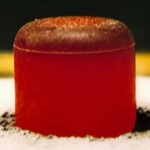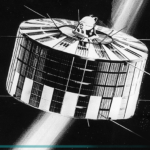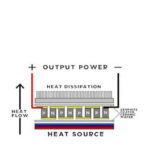Power-generation and heating units using radioactive decay as their primary energy source have been successfully used in space and on Earth for over 60 years.
Q: How much power does a single Pu-238 RTG core generate?
A: The newest thermoelectric converters using PbTe/TAGS-based thermocouples can produce between 100 and 125 Watts of electrical energy from Pu-238 fuel pellets over the course of 14 years. Of course, multiple pellets and associated thermocouple arrays can be combined for more total power.
Q: What power levels does an overall RTG provide?
A: Depending on the mission, the RTG may be sized to deliver between 100 W and 500 W at the start of the mission. Keep in mind that the number of watts the RPG delivers declines with time due to natural decay, irrespective of the load. This is unlike a conventional chemical battery where deliverable power is first defined by energy capacity (watt hours), while the watts that can be delivered usually remain fairly constant until the stored energy runs low.
The RTG power output steadily declines along a fully predictable path regardless of electrical power use, of course. But even older RTGs can provide power for 30, 40, 50, and more years with a dropping output level. Proof of this is seen in the Voyager 1 and Voyager 2 spacecrafts which launched a few months apart in 1977 and are still traveling, having left our solar system. Their 750-watt RPGs are down to about one-third of their launch value, but they are still functioning, powering a subset of onboard instruments and communications links, and sending useful data back to Earth about the heliosphere and beyond.
Q: What’s the heat-to-electricity efficiency of an RTG?
A: Not great: only about 5 to 10%, but any unused heat that is not converted to electricity is not wasted. Instead, it is routed to heat the associated electronics, a very necessary function. Note that in most electronic systems, getting rid of excess heat is the problem. In spacecraft, the problem has a different aspect: you want to keep the electronics warm enough to function, and you also need to get excess heat, if any, away from the spacecraft via radiational cooling.

Q: What does the rest of the RTG structure look like?
A: It is a self-contained cylinder assembly. Earlier versions such as those used in the Voyager 1 and 2 program had a radioactive source at the end of the cylinder surrounded by thermocouples (Figure 1). Newer ones such as the one used for the Mars Curiosity project (launched in 2011) have the radioactive source at one end, and the heat of the decay is conducted to an array of thermocouples surrounding the other end (Figure 2).
Q: What does an RPG look like?
A: An RTG is about a meter and a half long, and 75 centimeters in diameter (Figure 3).

Q: What’s the Multi-Mission Radioisotope Thermoelectric Generator?
A: The most recent version of the space-bound RTG is the multi-mission radioisotope thermoelectric generator (MMRTG). It is based on the type of RTG flown previously on the two Viking landers and the Pioneer 10 and 11 spacecraft (the SNAP-19 RTG).
As a standard design, it can be used in either the vacuum of space or within the atmosphere of a planet for an orbiting satellite. The excess heat energy from an MMRTG can be used as a convenient and steady source of warmth to maintain proper operating temperatures for a spacecraft and its instruments in cold environments.

Q: What are some special circuit-power considerations when using an RTG as a power source
A: There are many which are not obvious at first. For example, the RTG starts creating heat and the radioactive material starts decaying as soon as the Pu-238 is fabricated. Therefore, unlike a conventional battery which only has its self-discharge loss if there is no load, the RTG must be used as soon as possible. If the mission is delayed, some of the future energy of the RTG will be lost as it cannot be shut off.
Q: Is that all?
A: No, there’s another consideration that differs from a circuit using conventional batteries. With the latter, it’s critical to minimize power use in order to save the battery. With RTGs, the source power is being generated whether used or not, so it’s “use it or lose it.” This changes the operational tactics for turning circuit function on or putting them into a quiescent state to save power. Shutting them down does not extend the viable life of the RTG, as it continues to deliver heat and thus electrical power regardless of use. Again, the heat can also be used to keep the instrumentation warm.
Q: How much does an RTG cost?
A: That’s a very hard question to answer, primarily because there are so many overhead structural costs associated with creating the Pu-238 isotope. For example, how do you figure the cost of the irradiation facility such as the one at Oak Ridge? Still, the estimate for a single, complete RTG is between $100 and $150 million.
Q: What about safety? After all, a radioisotope emitting radiation is at the heart of the RTG (or the RHU).
A: Obviously, this is a major design consideration, and there has never been a safety issue with any of the many RTU/RHU units. Their design and fabrication must meet a long list of safety tests and standards from multiple regulatory agencies, including modeling, simulations, “what if” scenario analysis, and physical tests.
Q: What are some specifics of the fuel-element construction?
A: The plutonium dioxide fuel is a specially refined, fire-resistant ceramic material that is manufactured and used in the form of pellets to reduce the possibility of dispersing the fuel in a launch or reentry accident. If fractured, the ceramic — like a broken coffee cup — tends to break into relatively large particles and chunks that pose significantly less hazard than inhalable microscopic particles. Further, this ceramic resists being dissolved in water and resists reaction with other chemicals.
Multiple layers of protective material protect and contain the fuel and reduce the chance of a release of plutonium dioxide should an accident occur. Fire concerns are addressed with the plutonium dioxide pellets clad in iridium, a corrosion-resistant metal with a high melting point above 4,820°F/2,660°C.
The final part of this article looks at the details of the radioactive heating unit.
Related EE World Content
Thermal electric generators, Part 1: Principles and implementation
Thermal Electric Generators, Part 2: Applications
Gravity-assist “Slingshot,” Part 1: Background and principle
Gravity-assist “Slingshot,” Part 2: Application
Making sense of thermocouples and interfaces (Part 1)
External References (with some comments)
NASA, JPL, Dept. of Energy
- NASA/JPL, “Radioisotope power systems reference book for mission designers and planners” (Detailed, fact-packed 91-page book!)
- NASA/JPL. “A Look at the Next Generation of Radioisotope Thermoelectric Generators” (15 slides, excellent)
- NASA, “Cassini Radioisotope Thermoelectric Generators (RTGs)”
- NASA, “After 60 Years, Nuclear Power for Spaceflight is Still Tried and True”
- NASA, “RHU Pull-Apart Animation”
- NASA, “FAQ About RPS” (very useful)
- NASA, “A Step Forward in Reestablishing the Radioisotope Power Systems Supply Chain” (plutonium production issues)
- NASA, “Power Systems” (summary with video of RTGs)
- NASA, “Thermal Systems” (summary with video of RTUs)
- NASA, “NASA’s RHU-Heated and RTG-Powered Spacecraft” (broad overview)
- NASA, “So What’s an RTG and Are They Safe?
- NASA, “General Purpose Heat Source – Light-Weight Radioisotope Heater Unit”
- NASA, “RHU Fact Sheet”
- S. Department of Energy, “What is a Radioisotope Power System?”
- S. Department of Energy, “The History of Nuclear Power in Space”
- S. Department of Energy, “Overview of Light Weight Radioisotope Heater Unit (LWRHU) User’s Guide”
Other sources
- American Nuclear Society, Science and Technology Policy Institute,” Current Status and Future of Space Nuclear Power” (provides various technical and policy perspectives)
- Stanford University, “An Overview of Radioisotope Thermoelectric Generators”
- Wikipedia, “Radioisotope heater unit”
- Wikipedia, “Radioisotope thermoelectric generator”
Earth’s heat and radioactivity
- University of Notre Dame Nuclear Science Laboratory “Radioactivity, Lecture 11: The radioactive Earth”
- Physics World, “Radioactive decay accounts for half of Earth’s heat”
- Scientific American, “Do transuranic elements such as plutonium ever occur naturally?”
- Lawrence Berkeley National Laboratory “What Keeps the Earth Cooking?”







Leave a Reply